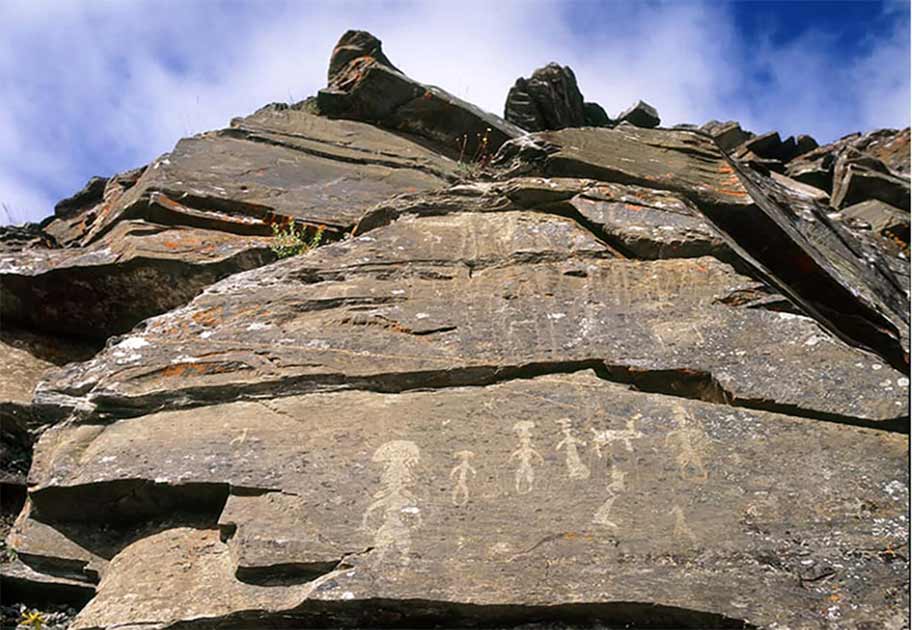Russia’s Fascinating Remote “Magic Mushroom” Pegtymel Petroglyphs
Russia’s Pegtymel petroglyphs, 2,000-year-old artworks found in a remote area of Arctic Russia, have been revealed to show scenes of hunting, and ritual hallucinogenic mushroom use. The telling images displayed on the Pegtymel petroglyphs are spread over the faces of 350 rocks in a location so remote it is only accessible by helicopter.
Known as Eurasia ’s most northern art gallery, situated high above the right bank of the Pegtymel River, near the East Siberian Sea, these 2,000-year-old paintings represent the only rock art discovered in Russia above the Arctic Circle. Pevek, the nearest town to “Pegtymel, Chukotka” and its so-called “ancient art gallery,” is located around 5,555 km (3,452 miles) east of Moscow, in Russia ’s easternmost corner.
Yelena Levanova, head of PaleoArt Centre at Russian Institute of Archeology, is leading the new research. She told Siberian Times that the so-called “Pegtymel petroglyphs” were first discovered by Soviet geologists in 1967.
This summer, the first scientific expedition since 2008 worked at the site. The five archaeologists and three volunteers not only preserved the most unique drawings, but they took high resolution photographs so that detailed 3D models of the Pegtymel petroglyphs can eventually be made.

The Pegtymel Petroglyphs’ mushroom-headed figures are causing a stir in archaeological circles. (Institute of Archaeology Russian Academy of Sciences)
The Pegtymel Petroglyphs: Eurasia’s Northernmost Art Gallery
What is described as a “spectacular art gallery” covers the faces of more than 350 stones. Each stone easel holds dozens of individual images depicting ancient hunters crossing rivers and interacting with whales and reindeer, and dogs are seen chasing a brown bear on one rock surface. Levanova said these “stunning, dynamic and expressive petroglyphs are one of the least studied on Earth.”
Most of the images were executed with white quartz that made fine white lines on the darker bedrock background. Perhaps the most unique aspect of this ancient art gallery are groups of petroglyphs showing men and women with a large mushroom on their heads. Furthermore, there are other forms described as “mushroom people” who have one or more mushrooms actually replacing their heads and other paintings show people with legs shaped like mushroom stems.
- Lipci’s Prehistoric Rock Paintings: Montenegro’s Primitive Art Site
- Altai Rock Art Images Reveal Insights Into Ancient Nomadic Culture
The Siberian Times article says Russian archaeologists have called the half-human half-mushroom forms “fly agaric people.” According to Wild Food UK “Amanita muscaria” is commonly known as “fly agaric” or “fly amanita.” The mushroom’s name is derived from the medieval practice of breaking the mushroom caps in milk as a way to stupefy flies. This species of mushroom is widely known as a powerful hallucinogenic mushroom, the one that assisted Alice ’s trip into Wonderland and that perhaps inspired our modern red and white-suited Santa Claus with his red-nosed flying reindeer.

The Pegtymel Petroglyphs also reveal what these ancient Arctic people were hunting, as these “elk-like” creatures reveal. (Institute of Archaeology Russian Academy of Sciences)
Stories Of Ancient Arctic Risk-taking Hallucinogenic Trippers
Dr Mikhail Bronstein is the chief researcher at the Russian State Museum of Oriental Art. He said the people depicted in the ancient art were often shown with their “arms spread apart, and legs slightly bent at the knees.” The leading hypothesis suggests these forms illustrate “a ritual, magical dance, comparable to the dances of shamans.” Dr Bronstein added that the people were clearly skilled hunters as they knew how to use dogs to attack brown bears and how to hunt whales and reindeer from boats with spears.
Furthermore, despite being so remote, it is known these the hunters had relationships with people far to the south. This became evident when it was discovered that some of the petroglyphs were carved with metal chisels, that must have been imported. Dr Bronstein said this single discovery also means the people who inhabited Chukotka 2,000 years ago, “were pioneers ready to take risks, like venturing to unknown foreign lands.”

This Pegtymel petroglyph reveals a herd of deer on a remote cliffside location. (Institute of Archaeology Russian Academy of Sciences)
An Ancient Rock Art Gallery For All The World
Dr Bronstein said the Pegtymel petroglyphs offer “the rare opportunity to look into the mysterious world of mythological representations of ancient people.” The researchers plan returning to Pegtymel next summer to continue photographing the petroglyphs. The aim is to map and them reconstruct the entire ancient gallery in 3D and then to offer the world free online access the collection of Arctic petroglyphs.
- 4,000-Year-Old Art Gallery Found in Siberia
- The Glösa Rock Art in Sweden Provides a Peek Into the Lives of Stone Age Hunters
The professor hopes that the new online project will help “destroy the myth that still exists today about the cultural backwardness of Chukotka.” In reality this remote Arctic outpost was thriving with polar hunters, trading nomads, sailors, recreational drug users and artists 2,000 years ago.”
Top image: The Pegtymel petroglyphs depicting hallucinogenic mushroom-headed figures, which is evidence of the use of magic mushrooms 2,000 years ago in northeast Russia. Source: Institute of Archaeology Russian Academy of Sciences
By Ashley Cowie



















